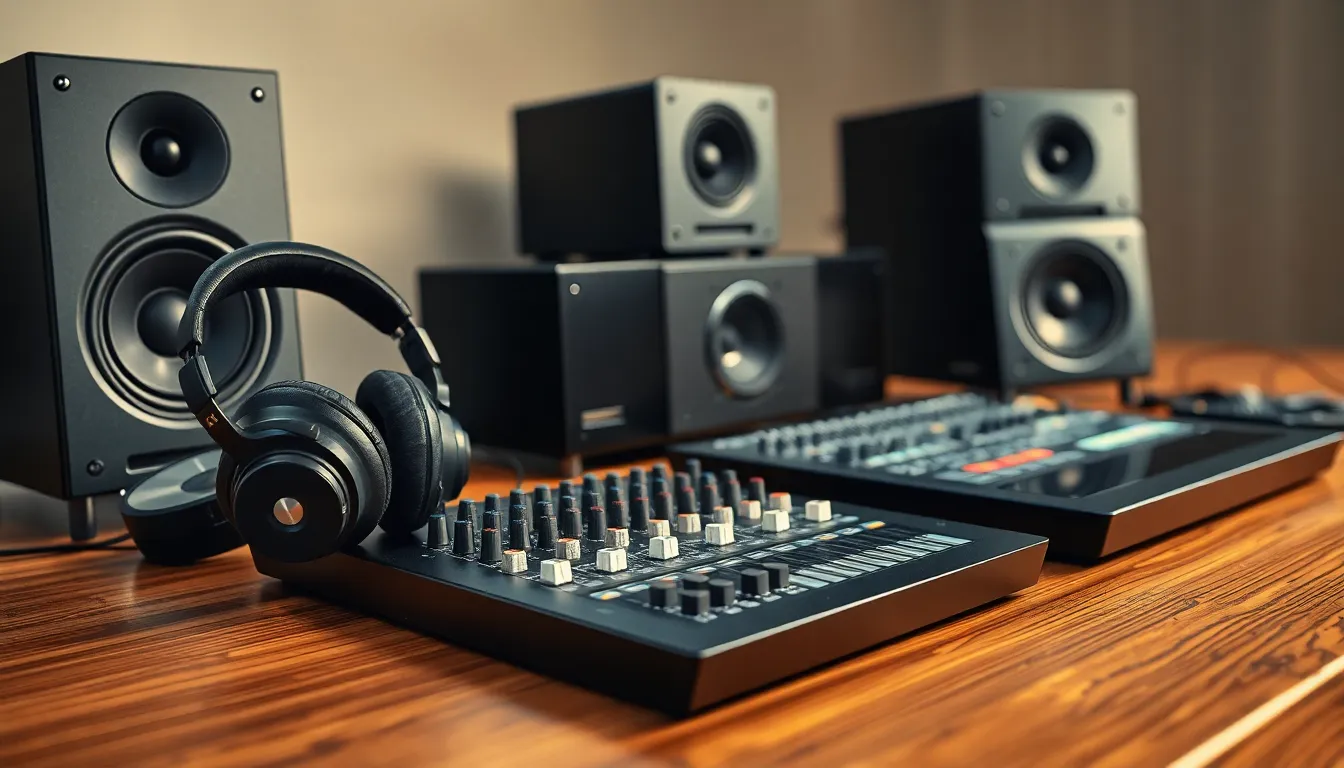In a world where sound quality can make or break an experience, choosing the right audio equipment is crucial. Whether it’s for music production, gaming, or simply enjoying your favorite tunes, the right gear enhances every moment. With countless options available, navigating the audio landscape can feel overwhelming.
This article dives deep into audio equipment reviews, offering insights into the latest headphones, speakers, and studio monitors. Each review focuses on performance, durability, and value, helping readers make informed decisions. Discovering the perfect audio setup doesn’t have to be a daunting task; it can be an exciting journey toward superior sound.
Table of Contents
ToggleTypes of Audio Equipment
Understanding the various types of audio equipment helps in selecting the most suitable gear for specific needs. Here’s a detailed look at common audio equipment types.
Headphones
Headphones provide a personal listening experience, making them ideal for music lovers, gamers, and audio professionals.
- Over-ear headphones offer superior sound quality and noise isolation, perfect for studio work.
- On-ear headphones maintain a balance between portability and sound performance, suitable for casual listening.
- In-ear monitors (IEMs) deliver exceptional sound clarity and detail, popular among musicians for live performances.
Speakers
Speakers differ in design and function, catering to various audio requirements.
- Bookshelf speakers fit well in small spaces while delivering impressive sound quality, suitable for home audio setups.
- Floor-standing speakers provide robust sound with deeper bass, ideal for larger rooms or home theater systems.
- Portable Bluetooth speakers offer convenience for outdoor use, allowing mobile listeners to enjoy quality audio on the go.
Amplifiers
Amplifiers boost audio signals, enhancing overall sound quality and volume.
- Integrated amplifiers combine a preamp and power amp, simplifying audio setups for casual listeners.
- Dedicated power amplifiers enhance power output and sound fidelity, essential for high-performance audio systems.
- Headphone amplifiers improve sound clarity and detail for headphones, making them vital for audiophiles.
Microphones
Microphones capture sound effectively, essential for recording and broadcasting.
- Dynamic microphones excel in live settings, handling high sound pressure levels well, making them suitable for vocals and instruments.
- Condenser microphones provide superior detail and frequency response, ideal for studio recordings.
- Lavalier microphones are discreet and often used in video production, allowing hands-free operation.
Factors to Consider in Audio Equipment Reviews

Selecting audio equipment demands careful consideration of several key factors that influence overall satisfaction and performance.
Sound Quality
Sound quality significantly impacts the listening experience. Analyze frequency response, clarity, and distortion levels. Consider specifications such as the range of frequencies (e.g., 20 Hz to 20 kHz) to ensure the equipment reproduces sound accurately. Look for products that receive consistent praise for their tonal balance and immersive soundstage, which enhance enjoyment across various genres.
Build Quality
Build quality determines the longevity and reliability of audio equipment. Examine materials used, construction techniques, and overall design. Durable components contribute to performance stability, especially in professional environments. Favor options with solid housings, reinforced connectors, and replaceable parts that withstand wear and tear.
Features
Features enhance usability and versatility. Assess compatibility with other devices, such as smartphones, computers, or mixers. Evaluate functionalities like noise cancellation in headphones, wireless connectivity, and customizable sound profiles. Look for equipment with intuitive controls and user-friendly interfaces, which streamline the listening experience.
Price
Price plays a pivotal role in selecting audio equipment. Compare costs across similar devices while weighing performance, features, and brand reputation. Establish a budget based on needs and frequency of use. Seek products that provide optimal value, offering a balance between quality and affordability. Track price changes and discounts to maximize investment.
Top Audio Equipment Brands
Choosing the right audio brand significantly impacts audio quality and user experience. Here’s a look at three leading brands known for their exceptional audio equipment.
Brand A
Brand A specializes in high-resolution audio devices. Known for its innovative technology, it offers a broad range of products, including headphones and speakers. This brand prioritizes sound clarity and craftsmanship, utilizing premium materials in its designs. Notable products include noise-canceling headphones suitable for both casual listeners and professionals.
Brand B
Brand B focuses on audio performance for both home and studio environments. It excels particularly in studio monitors and microphones. The brand is renowned for its flat frequency response, making it a favored choice among sound engineers. Many users appreciate its extensive product range, from budget-friendly to high-end options, ensuring something for every type of audio enthusiast.
Brand C
Brand C is recognized for its portable audio equipment, including Bluetooth speakers and in-ear monitors. This brand combines convenience and quality, making it ideal for on-the-go listening. Its products are often equipped with long battery life and resistance to water and dust, appealing to adventurous users. Customer reviews frequently highlight the deep bass and clear highs, providing robust sound in compact designs.
Tips for Reading Audio Equipment Reviews
Reading audio equipment reviews effectively requires attention to specific details that influence overall performance. Keeping these key aspects in mind can help streamline the selection process.
Understanding Specifications
Specifications provide essential insights into audio equipment capabilities. Focus on crucial specifications such as frequency response, impedance, and sensitivity.
- Frequency Response: This metric indicates the range of sounds the equipment can reproduce. Look for a balanced frequency response for an accurate sound profile.
- Impedance: Affects compatibility with devices. Lower impedance generally suits portable devices, while higher impedance works better with dedicated amplifiers.
- Sensitivity: Higher sensitivity means louder sound at a given power level, making it vital for headphones and speakers.
Understanding these specifications helps assess how the audio gear will perform in specific scenarios.
Cross-Referencing Reviews
Cross-referencing multiple reviews offers a comprehensive view of the equipment’s performance. Use the following strategies:
- Diverse Sources: Check both professional audio review sites and user-generated reviews. This variety highlights differences in experiences and expectations.
- Common Themes: Look for consistent feedback among reviewers. Recurring praises or complaints can reveal strengths or weaknesses.
- Contextual Relevance: Ensure that reviews relate to the intended usage. For instance, studio monitors will have different priority factors compared to portable speakers.
Cross-referencing different types of reviews ensures a well-rounded understanding of the product.
Listening Tests
Listening tests provide the most direct evaluation of audio quality. Consider the following aspects during testing:
- Varied Genres: Play a range of music genres. Different styles may highlight strengths and weaknesses in sound reproduction.
- Volume Levels: Test at various volume levels to assess clarity and distortion. Reliable equipment should maintain sound integrity across the volume spectrum.
- Personal Preference: Trust personal preferences when evaluating sound quality. Listening environments vary; identify what sounds best in the user’s typical setting.
Conducting listening tests supplies practical insights that specifications alone cannot provide.
Choosing the right audio equipment can transform the listening experience into something exceptional. With the right insights and guidance, individuals can navigate the vast array of options available. Prioritizing sound quality, build quality, and features ensures a satisfying selection process.
By understanding specifications and conducting thorough research, readers can make informed decisions that align with their specific needs. Engaging with reviews and testing different products ultimately leads to an optimal audio setup that enhances enjoyment, whether for music production, gaming, or casual listening. Embracing this journey not only simplifies the process but also enriches the overall audio experience.





